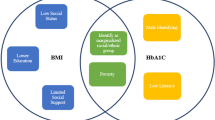ABSTRACT
BACKGROUND
We deployed a study design that attempts to account for racial differences in socioeconomic and environmental risk exposures to determine if the diabetes race disparity reported in national data is similar when black and white Americans live under similar social conditions.
DESIGN & METHODS
We compared data from the 2003 National Health Interview Survey (NHIS) with the Exploring Health Disparities in Integrated Communities-Southwest Baltimore (EHDIC-SWB) Study, which was conducted in a racially-integrated urban community without race differences in socioeconomic status.
RESULTS
In the NHIS, African Americans had greater adjusted odds of having diabetes compared to whites (OR: 1.61, 95% CI: 1.26−2.04); whereas, in EHDIC-SWB white and African Americans had similar odds of having diabetes (OR: 1.07, 95% CI: 0.71−1.58). Diabetes prevalence for African Americans was similar in NHIS and EHDIC-SWB (10.4%, 95%CI: 9.5−11.4 and 10.5%, 95%CI: 8.5−12.5, respectively). Diabetes prevalence among whites differed for NHIS (6.6%, 95%CI: 6.2−6.9%) and EHDIC-SWB (10.1%, 95%CI: 7.6−12.5%).
CONCLUSIONS
Race disparities in diabetes may stem from differences in the health risk environments that African Americans and whites live. When African Americans and whites live in similar risk environments, their health outcomes are more similar.
Similar content being viewed by others
References
Mokdad AH, Bowman BA, Ford ES, Marks VF, Koplan JP. The continuing epidemics of obesity and diabetes in the United States. JAMA. 2001;10:1195–200.
Bachmann MO, Eachus J, Hopper CD, et al. Socio-economic inequalities in diabetes complications, control, attitudes and health service use: a cross-sectional study. Diabet Med. 2003;20:921–9.
Miller ST, Schlundt DG, Larson C, Reid R, Pichert JW, Hargreaves M, Brown A, McClellan L, Marrs M. Exploring ethnic disparities in diabetes, diabetes care, and lifestyle behaviors: the Nashville REACH 2010 community baseline survey. Ethn Dis. 2004;14(3 Suppl 1):38–45.
Sequist TD, Fitzmaurice GM, Marshall R, et al. Physician performance and racial disparities in diabetes mellitus care. Arch Intern Med. 2008;168:1145–51.
Figaro K, Elasy T, BeLue R, Speroff T, Dittus R. Exploring Socioeconomic Variations in Diabetes Control Strategies: Impact of Outcome Expectations. JNMA;101:18–23.
Maskarinec G, Grandinetti A, Matsuura G, Sharma S, Mau M, Henderson BE, Kolonel LN. Diabetes prevalence and body mass index differ by ethnicity: the Multiethnic Cohort. Ethn Dis. 2009;19:49–55.
LaVeist TA. Disentangling Race and Socioeconomic Status: A Key to Understanding Health Inequalities. J Urban Hlth. 2005;82:26–34.
Navarro V. Race or class versus race and class: mortality differentials in the United States. Lancet. 1990;336:1238–40.
LaVeist TA. Racial segregation and longevity among African Americans: An individual-level analysis. Hlth Serv Res. 2003;38:1719–34.
LaVeist TA Wallace JM. Health risk and inequitable distribution of liquor stores in African American neighborhood. Soc Sci Med. 2000;51:613–7.
Williams DR, Collins C. Racial residential segregation: a fundamental cause of racial disparities in health. Pub Hlth Rep. 2001;116:404–16.
CDC. Health disparities experienced by black or African Americans - United States. MMWR Weekly Report. 2005;5:41–3.
LaVeist TA, Thorpe R Jr, Bowen-Reid T, Jackson J, et al. Exploring Health Disparities in Integrated Communities: Overview of the EHDIC Study. J Urban Hlth. 2008;85:11–21.
NCHS. National Health Interview Survey: Public Use Data Release, NHIS Survey Descritption. 2003, National Center for Health Statistics: Hyattsville.
LaVeist TA, Thorpe R, Mance G, Jackson J. Overcoming confounding of race with socio-economic status and segregation to explore race disparities in smoking. Addiction. 2007;102:65–70.
Gaskin DJ, Spencer CS, Richard R, Anderson G, Powe NR, LaVeist TA. “Do hospitals provide lower quality care to minorities compared to whites?”. Hlth Aff. 2008;27:518–27.
Drewnowski A. Obesity and the food environment—dietary energy density and diet costs. Am J Prev Med. 2004;27:154–62.
Roos E, Lahelma E, Virtanen M, Prattala R, Pietinen P. Gender, socioeconomic status and family status as determinants of food behavior. Soc Sci Med. 1998;46:1519–29.
Parks SE, Houseman RA, Brownson RC. Differential correlates of physical activity in urban and rural adults of various socioeconomic backgrounds in the United States. J Epidemiol Community Health. 2003;57:29–35.
Gordon-Larsen P, Nelson MC, Page P, et al. Inequality in the built environment underlies key health disparities in physical activity and obesity. Pediatrics. 2006;117:417–24.
Resnick B, Luisi D, Vogel A, et al. Reliability and validity of the self-efficacy for exercise and outcome expectations for exercise scales with minority older adults. J Nurs Meas. 2004;12:235–47.
Clark DO, Nothwehr F. Exercise self-efficacy and its correlates among socioeconomically disadvantaged older adults. Health Educ Behav. 1999;26:535–46.
Goldman N, Lin IF, Weinstein M, Lin YH. Evaluating the quality of self-reports of hypertension and diabetes. J Clin Epidemiol. 2003;56:148–54.
National Institutes of Health. National Diabetes Information Clearinghouse. National Diabetes Statistics. 2007. http://diabetes.niddk.nih.gov/dm/pubs/statistics/index.htm Accessed 6/7/2009.
Quinn, L. and Pawasarat, J. "Racial Integration in Urban American: A Block Level Analysis of African American and White Housing Patterns." Employment and Training Institute, School of Continuing Education, University of Wisconsin-Milwaukee. 2003.
Acknowledgements
This research was supported by grant # P60MD000214-01 from the National Center on Minority Health and Health Disparities (NCMHD) of the National Institutes of Health (NIH), and a grant from Pfizer, Inc.
Conflict of interest
None disclosed.
Author information
Authors and Affiliations
Corresponding author
Rights and permissions
About this article
Cite this article
LaVeist, T.A., Thorpe, R.J., Galarraga, J.E. et al. Environmental and Socio-Economic Factors as Contributors to Racial Disparities in Diabetes Prevalence. J GEN INTERN MED 24, 1144–1148 (2009). https://doi.org/10.1007/s11606-009-1085-7
Received:
Revised:
Accepted:
Published:
Issue Date:
DOI: https://doi.org/10.1007/s11606-009-1085-7




